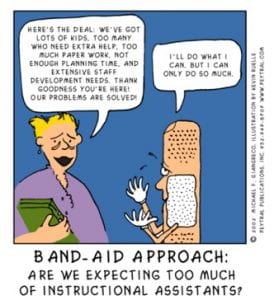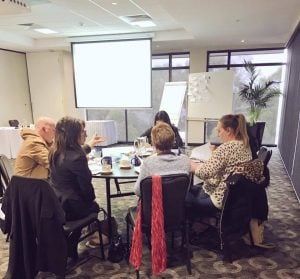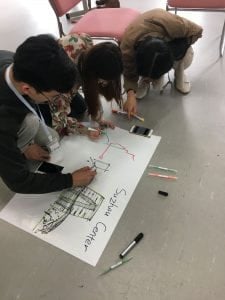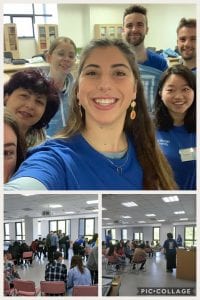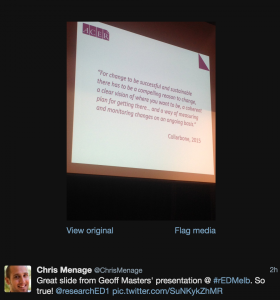It’s been only a few weeks since arriving back in Australia after a whirlwind 2 weeks teaching English Conversation classes to university students in Suzhou, China.
While we all hit the ground running catching up with missed classes, study, assessments, meetings, scheduled workshops, family, and life in general here in Australia, a day hasn’t passed that I have not thought about Suzhou. It was a challenging, yet wonderful experience. Not many can say, “Hey, I spent 2 weeks in China teaching English conversation to Masters students.” A-mazing.
This is the last of my Suzhou series and the longest, but it is only now that I feel I can share my learning.
Suzhou Seven
From the very beginning, we dubbed ourselves Suzhou Seven.
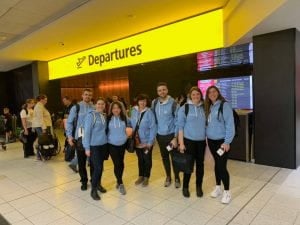
Suzhou Seven
Our team leader, Ros worked tirelessly with staff and students in Suzhou, making connections, delivering workshops and running sessions for PhD students who may one day visit and study in Australia. We got to work with 5 young, energetic undergraduate students who possess qualities that are akin to veteran teachers but have no teaching qualifications nor are they studying education.

The Amazing Five (L to R; Eliza, Louis, Jeannie, Gaby & Matt)
Every day we seven facilitated eight ‘Let’s Chat’, English conversational classes, hosting about 240 students from different faculties including Translation & Interpreting, Transportation, Information Technology, Geomechanics/Water Resources, International Business and Industrial Design. We delivered workplace sessions on presenting yourself, networking, and preparing speeches. We collected data for our research about people’s experiences and attended Chineses language sessions every morning. We held planning meetings every day to discuss our workshops and ensure we were meeting the needs of our students. Together, Suzhou Seven was and remains a team to be reckoned with.
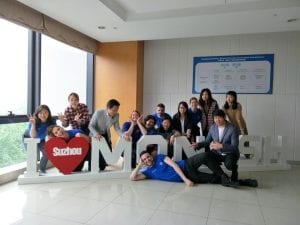
Hanging out with our support staff in Suzhou
A cast of thousands
Chris Wen, the General Manager at Monash Suzhou very graciously hosted us with the support staff who worked behind the scenes to ensure our stay was fabulous. They organised our teaching schedules, booked the rooms, bought supplies, booked our cultural experiences, advised us about where to go and how to get there. Matt, our resident Monash staff member in Suzhou, looked after us, giving up his office & the key to the photocopier, showing us around, finding little coffee shops, and giving us invaluable advice on local customs. Winnie, one of our favourite PhD students, took time out of her studies to teach us the language and culture of China every morning. A number of others joined us for evening
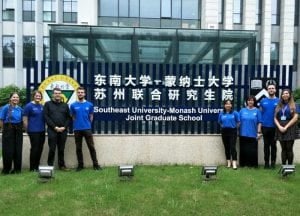
Where’s Matt?
cultural experiences including dinners, boat rides, shopping and, of course, karaoke night! Our students were always ready to suggest local eating spots, many helped us order our food when they spied us trying our best to order food unsuccessfully! Some even bought us bubble tea and snacks to try. Peer to peer relationships soon grew and the students began to lead conversations, asking facilitators questions and engaging in ‘small talk’. It felt so good knowing that just being there, taking the time to listen boosted our students’ confidence to communicate in English and made them feel they could do it outside of the classes themselves.
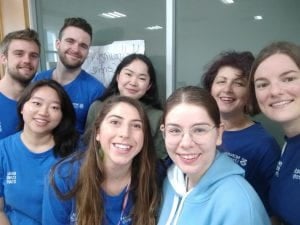
Winnie & Suzhou Seven
Language barrier
I’ve travelled many times overseas, especially over the last dozen years, but this was my first visit to an Asian country. My personal challenge in this regard was the language. For the first time, I experienced a real dilemma in that I literally could not understand the language. Don’t get me wrong, this is not a reflection on the people but a personal realisation. I felt hopeless and even anxious when out and about. I have not felt like this before. Even in countries where I was not overly familiar with the language, I felt I could manage and I did and maybe that was because of my European background. As an educator with many years of experience, I pride myself on being able to understand and interpret what people are saying out loud and internally. I felt I was really in tune with this but now I realise that while my ‘sixth’ sense works in some places, it made little sense to me while I was in China. As an independent, strong middle-aged female I suddenly felt unsure of myself and began relying on my fellow travellers and on the students with whom we were developing strong relationships.
Teaching (and learning) with passion
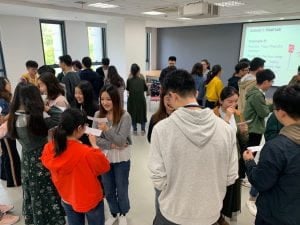
Buzzing
As a teacher of many years, actually, many, many years I’ve always been open to learning new things but still pride myself on being able to engage my students no matter the content. After all, it’s what I do. I’ve had many experiences also with devising, writing and implementing many programs and curriculum outlines. It was my redevelopment and extension of the existing Let’s Chat units that we based our workshops on during our time in Suzhou. I spent many hours writing, re-writing and meeting with my colleagues to ensure we were on track to meet all the requirements from our host university but still, I felt tense and nervous as I shared in my first and second Suzhou posts.
While it was wonderful to meet our students on that first day, engaging them was a different matter. You see many had very busy study schedules and these classes were slotted into their day. It was our responsibility to make those classes so engaging and relevant that they would keep coming. What I learned over the time working with my team was that they loved doing Let’s Chat as much as I did. The other thing I learned was that passion for what and how you teach is contagious no matter where you are and we all caught that bug. The students kept coming and while those first few days were tough, our confidence was building, we reflected and planned each day to make each session more relevant and as we got to know our students more and more our classes were buzzing. Confidence was building not only in our students but in us as visiting teachers.
And now?
On returning to Australia, to Melbourne, to Monash and to English Connect, I bring with me a different confidence. In my first workshop this week I shared that I had just returned from teaching English in China and I cannot describe the pride I felt in simply articulating that achievement out loud with our international students who attend our workshops. Their smiles and nods of approval cemented in me a sudden realisation that I just want to do it again! I want to do it better. I want to experience more. I want to learn more. I want to keep making a difference.
We haven’t yet had a chance to meet as a team again and share our experience and our thoughts about our Suzhou adventure. Marta, the reason we went to China in the first place and the driver behind what we were able to do is away at the moment but I’m sure she can’t wait to hear. A special thank you should go out to our team back at Monash who held the fort while we were away. Lucas, who had to do both his and Ros’s job, Belinda, without whose help we would never have been able to get out visas and our money, to Negar and Lilian who love excel files and crunch the numbers for us, to the admin staff who re-formatted and copied all our files so we could use them effectively in our classes. And to anyone else who had a hand in getting us to Suzhou and back. I’m personally hoping that this is the first of many associations we have, not only with our colleagues in Suzhou but hopefully, in time, with other Monash Universities around the world. We’ve got this!
To find out what we do at English Connect please visit our website.
Thanks for reading 🙂
